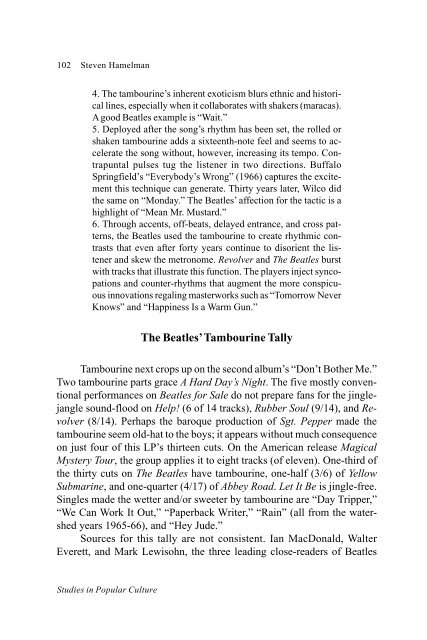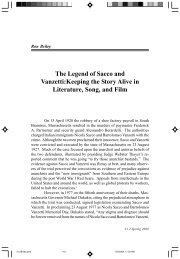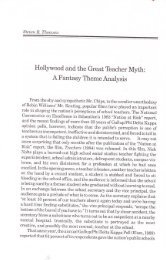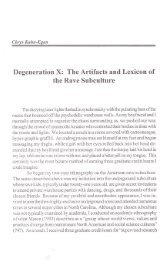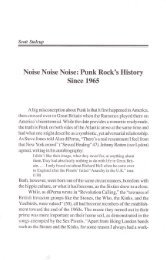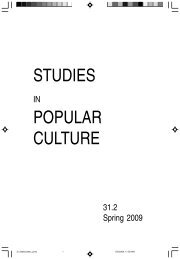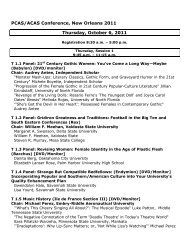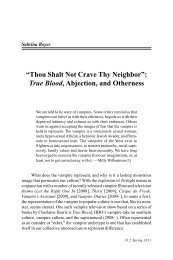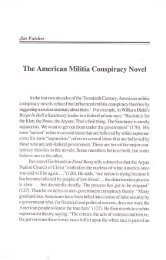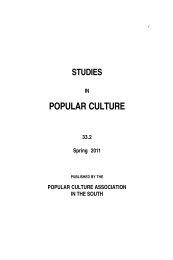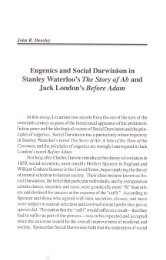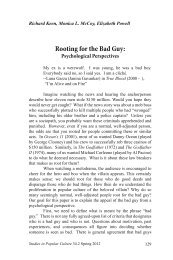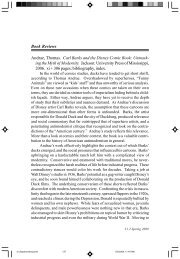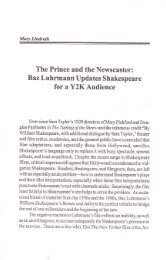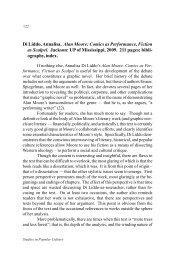The Beatles and the Art of the Tambourine - Popular/American ...
The Beatles and the Art of the Tambourine - Popular/American ...
The Beatles and the Art of the Tambourine - Popular/American ...
Create successful ePaper yourself
Turn your PDF publications into a flip-book with our unique Google optimized e-Paper software.
102 Steven Hamelman<br />
4. <strong>The</strong> tambourine’s inherent exoticism blurs ethnic <strong>and</strong> historical<br />
lines, especially when it collaborates with shakers (maracas).<br />
A good <strong>Beatles</strong> example is “Wait.”<br />
5. Deployed after <strong>the</strong> song’s rhythm has been set, <strong>the</strong> rolled or<br />
shaken tambourine adds a sixteenth-note feel <strong>and</strong> seems to accelerate<br />
<strong>the</strong> song without, however, increasing its tempo. Contrapuntal<br />
pulses tug <strong>the</strong> listener in two directions. Buffalo<br />
Springfield’s “Everybody’s Wrong” (1966) captures <strong>the</strong> excitement<br />
this technique can generate. Thirty years later, Wilco did<br />
<strong>the</strong> same on “Monday.” <strong>The</strong> <strong>Beatles</strong>’ affection for <strong>the</strong> tactic is a<br />
highlight <strong>of</strong> “Mean Mr. Mustard.”<br />
6. Through accents, <strong>of</strong>f-beats, delayed entrance, <strong>and</strong> cross patterns,<br />
<strong>the</strong> <strong>Beatles</strong> used <strong>the</strong> tambourine to create rhythmic contrasts<br />
that even after forty years continue to disorient <strong>the</strong> listener<br />
<strong>and</strong> skew <strong>the</strong> metronome. Revolver <strong>and</strong> <strong>The</strong> <strong>Beatles</strong> burst<br />
with tracks that illustrate this function. <strong>The</strong> players inject syncopations<br />
<strong>and</strong> counter-rhythms that augment <strong>the</strong> more conspicuous<br />
innovations regaling masterworks such as “Tomorrow Never<br />
Knows” <strong>and</strong> “Happiness Is a Warm Gun.”<br />
Studies in <strong>Popular</strong> Culture<br />
<strong>The</strong> <strong>Beatles</strong>’ <strong>Tambourine</strong> Tally<br />
<strong>Tambourine</strong> next crops up on <strong>the</strong> second album’s “Don’t Bo<strong>the</strong>r Me.”<br />
Two tambourine parts grace A Hard Day’s Night. <strong>The</strong> five mostly conventional<br />
performances on <strong>Beatles</strong> for Sale do not prepare fans for <strong>the</strong> jinglejangle<br />
sound-flood on Help! (6 <strong>of</strong> 14 tracks), Rubber Soul (9/14), <strong>and</strong> Revolver<br />
(8/14). Perhaps <strong>the</strong> baroque production <strong>of</strong> Sgt. Pepper made <strong>the</strong><br />
tambourine seem old-hat to <strong>the</strong> boys; it appears without much consequence<br />
on just four <strong>of</strong> this LP’s thirteen cuts. On <strong>the</strong> <strong>American</strong> release Magical<br />
Mystery Tour, <strong>the</strong> group applies it to eight tracks (<strong>of</strong> eleven). One-third <strong>of</strong><br />
<strong>the</strong> thirty cuts on <strong>The</strong> <strong>Beatles</strong> have tambourine, one-half (3/6) <strong>of</strong> Yellow<br />
Submarine, <strong>and</strong> one-quarter (4/17) <strong>of</strong> Abbey Road. Let It Be is jingle-free.<br />
Singles made <strong>the</strong> wetter <strong>and</strong>/or sweeter by tambourine are “Day Tripper,”<br />
“We Can Work It Out,” “Paperback Writer,” “Rain” (all from <strong>the</strong> watershed<br />
years 1965-66), <strong>and</strong> “Hey Jude.”<br />
Sources for this tally are not consistent. Ian MacDonald, Walter<br />
Everett, <strong>and</strong> Mark Lewisohn, <strong>the</strong> three leading close-readers <strong>of</strong> <strong>Beatles</strong>


